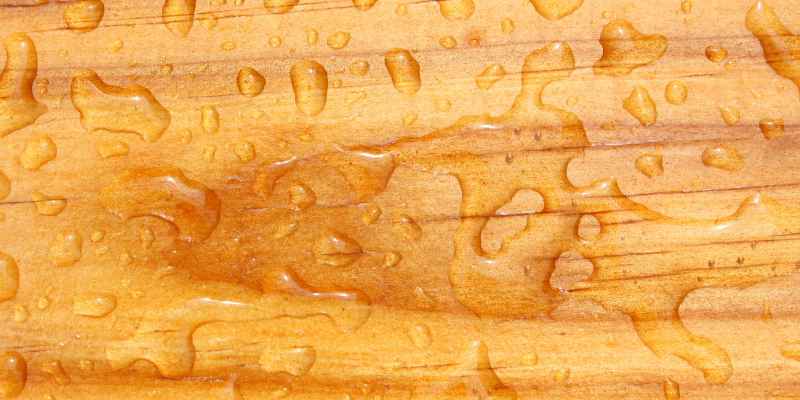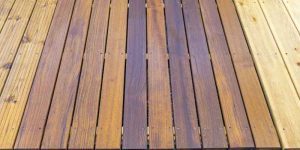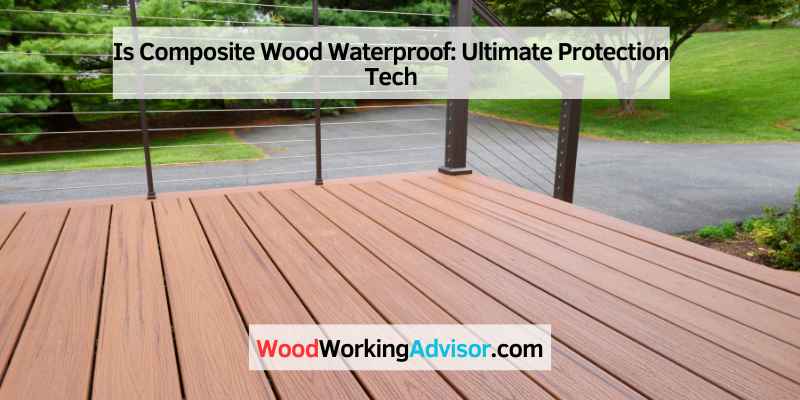Composite wood is not completely waterproof; it has the ability to absorb water and may expand or contract based on climate changes. This is a normal characteristic of composite decking, which is often described as water-resistant rather than waterproof.
However, it is possible to waterproof the underside of composite boards by using rubber flanges to fill gaps and prevent water from dripping underneath. While composite decking is highly resistant to rot, decay, and insect damage, it is recommended to seal or stain the surface to further protect it and extend its lifespan.
With proper maintenance, composite decking can provide several years of use before requiring cleaning.
The Misconception Of Waterproof Composite Wood
Composite wood is not completely waterproof; it can absorb water and may swell and shrink with changing climates, a normal occurrence. Hence, it’s often described as water-resistant rather than waterproof. Sealing or staining composite wood can prolong its use. To waterproof the underside, use rubber flanges to fill the gaps.
There is a common misconception surrounding composite wood, particularly composite decking, and its waterproof properties. While many people believe that composite wood is completely waterproof, the reality is that it is water-resistant but not entirely waterproof. This means that composite wood can absorb water and may expand or shrink as the climate changes. However, it is important to understand that this is a normal characteristic of composite wood and does not indicate a defect or poor quality.
Composite decking is a popular alternative to traditional wood decking due to its durability and low maintenance requirements. It is made from a combination of wood fibers and recycled plastic, creating a strong and long-lasting material. While composite decking is highly resistant to rot, decay, and insect damage, it is still susceptible to water absorption.
Unlike solid wood, composite decking is composed of multiple layers, with the outer layer acting as a protective barrier against moisture. This outer layer helps to prevent water from seeping into the core of the decking material. However, over time and with prolonged exposure to water, some moisture may still penetrate the surface and be absorbed by the inner layers of the composite wood.
Ensuring Water Resistance
In order to enhance the water resistance of composite decking, it is important to take preventive measures. One way to accomplish this is by properly sealing or staining the surface of the composite decking. This can help to create a protective barrier that repels water and prevents moisture absorption.
Additionally, it is crucial to ensure proper installation of the composite decking boards. Properly spaced flanges can be used to fill gaps between the decking boards, preventing water from dripping underneath and allowing for proper drainage. Some flanges are even designed to serve as mini waterways, directing water towards the edges of the decking.
Regular cleaning and maintenance of the composite decking are also essential to maintain its water-resistant properties. By keeping the surface clean and free of debris, you can prevent the buildup of moisture and minimize the risk of water damage.
While composite decking may not be completely waterproof, it offers a high level of water resistance that makes it suitable for outdoor use. By understanding its limitations and implementing proper maintenance practices, you can enjoy the benefits of composite decking for many years to come.
Water-resistant Vs. Waterproof
When it comes to composite wood, understanding the distinction between water-resistant and waterproof is crucial. While these terms may seem similar, they have significant differences that impact the material’s performance in various conditions.
Composite wood is often described as water-resistant due to its ability to withstand moisture to some extent. However, it’s essential to note that water-resistant materials can still be affected by water over time, leading to damage and deterioration.
On the other hand, waterproof materials are impervious to water penetration, providing a higher level of protection against moisture and preventing any damage or warping.
- Composite wood is not entirely waterproof but rather water-resistant.
- It can absorb water, leading to swelling and shrinkage in response to changes in climate.
- Proper maintenance, such as sealing or staining, can enhance the longevity of composite wood.
When it comes to waterproofing composite boards, using rubber flanges to fill gaps and prevent water infiltration underneath the decking can help maintain its structural integrity.
Exploring The Distinction
When it comes to composite wood, one common question that arises is whether it is waterproof or not. Understanding the distinction between water resistance and waterproofing is crucial for determining the suitability of composite wood in various environments.
Absorption Rate
Composite wood has the ability to absorb water to a certain extent, leading to swelling and shrinking as climate conditions fluctuate. The absorption rate of composite wood varies depending on the specific composition and construction of the material.
Effects Of Climate Changes
The impact of climate changes on composite wood can be significant. Changes in temperature and humidity levels can influence the behavior of composite wood, causing it to expand or contract. Understanding how composite wood reacts to different climate conditions is essential for optimal maintenance.
Realistic Expectations
Composite wood is not completely waterproof and can absorb water, leading to swelling and shrinkage with changes in climate. It is often described as water-resistant rather than waterproof. To prevent water from seeping under the boards, rubber flanges can be used to fill the gaps and create a mini waterway.
Regular sealing or staining can help maintain its durability.
Proper Sealing And Staining
Composite wood decking is not completely waterproof but is often described as water-resistant. However, it can still absorb water and may swell and shrink as the climate changes. To enhance the water resistance of composite wood, proper sealing and staining are recommended.
Sealing the surface of the composite decking helps to protect it from moisture intrusion. By applying a sealant, you create a barrier that prevents water from penetrating the wood fibers. This can significantly extend the lifespan of your composite wood and reduce the risk of issues such as warping, rot, and decay.
Staining the composite decking not only adds color and enhances its appearance but also provides an extra layer of protection. Stains contain additives that enhance the water resistance of the wood, making it more resistant to moisture absorption. Additionally, stains can help to prevent fading caused by UV rays, ensuring that your composite wood remains beautiful and vibrant for longer.
Maintenance Requirements
While composite wood decking requires less maintenance compared to traditional wood, it still needs regular care to ensure its longevity. Here are some maintenance recommendations for composite wood decking:
1. Regular cleaning: It is essential to clean your composite decking regularly to remove dirt, debris, and stains. This can be done using a soft brush or a low-pressure power washer. Avoid using harsh chemicals or abrasive scrubbers that can damage the surface of the wood.
2. Preventing mold and mildew: Composite wood is susceptible to mold and mildew growth, especially in damp and humid environments. To prevent this, ensure that water does not collect on the surface of the decking and clean any visible mold or mildew promptly using a mild detergent.
3. Inspecting for damage: Regularly inspect your composite wood decking for any signs of damage, such as cracks, splintering, or discoloration. Addressing these issues promptly can help prevent further damage and extend the lifespan of your decking.
4. Re-sealing and re-staining: Over time, the protective sealant and stain on the composite wood may wear off. It is recommended to re-seal and re-stain your decking as needed to maintain its water resistance and appearance. Follow the manufacturer’s guidelines for the appropriate products and application methods.
By following these maintenance requirements, you can ensure that your composite wood decking remains in good condition and performs well for many years. Proper sealing and staining, along with regular cleaning and inspections, will help protect your investment and enhance the durability of your outdoor space.
Understanding Composite Decking

Composite decking is water-resistant, but not completely waterproof. It can absorb water and may expand or contract with changes in climate. Applying rubber flanges to fill gaps and waterproofing the underside can help prevent water from dripping under the boards.
Composite decking has gained popularity in recent years due to its durability, low maintenance, and eco-friendliness. It is a blend of wood fibers and recycled plastic, providing a high-performance alternative to traditional wood decking. One common question among homeowners is whether composite wood is waterproof. Let’s delve into the key aspects of composite decking to gain a better understanding.
Durability and Resistance
Composite wood offers impressive durability and resistance to various environmental conditions. It is designed to withstand moisture, making it suitable for outdoor installations. While composite decking is not completely waterproof, it exhibits water-resistant properties. This means it can resist water infiltration to a certain extent, preventing rot, decay, and damage caused by moisture.
Comparing Strength with Natural Wood
When it comes to strength, composite wood excels compared to natural wood. Its engineered design enhances its resistance to warping, splintering, and insect infestations, attributes that are often a concern with traditional wood decking. Additionally, composite wood requires minimal maintenance, eliminating the need for regular staining or sealing, unlike natural wood.
Is Composite Wood Waterproof? – Ultra Decking
Can composite wood get wet? Composite decking is not completely waterproof; it can absorb water and will generally swell and shrink as the climate changes. This is completely normal. You will often hear composite decking described as water-resistant rather than waterproof.
Is composite wood rot resistant? Durability: Composite decking is highly resistant to rot, decay, and insect damage. This makes it a good choice for decks in coastal areas or other humid climates. Low maintenance: Composite decking requires very little maintenance.
How do you waterproof composite boards? To waterproof the underside of the composite board, use rubber flanges to fill the gaps. Applying flanges on the spaces between the decking will keep water from dripping under the composite decking boards. Some flanges are designed to serve as a mini waterway to flow toward the decking edges.
In conclusion, composite wood decking is a durable and water-resistant alternative to traditional wood, offering long-lasting performance and minimal maintenance. Whether seeking a deck for outdoor entertaining or leisure, composite decking provides a reliable and attractive solution.
Durability And Resistance
When it comes to choosing decking materials, durability and resistance are two crucial factors to consider. Composite wood is known for its exceptional durability and resistance to various environmental elements. Let’s dive into how composite wood excels in terms of rot and decay resistance as well as insect damage prevention.
Rot And Decay Resistance
Composite wood is highly resistant to rot and decay, making it an ideal choice for outdoor structures such as decks and fences. Unlike natural wood, composite wood does not succumb to rot when exposed to moisture and humidity. This resistance to rot ensures that composite wood maintains its structural integrity over time, even in humid climates.
Insect Damage Prevention
One of the key advantages of composite wood is its ability to prevent insect damage. Traditional wood is often vulnerable to termite infestations and other insect-related issues, which can compromise the long-term stability of outdoor structures. In contrast, composite wood is engineered to resist insect damage, providing peace of mind for homeowners.
In addition to its resistance to rot, decay, and insects, composite wood also offers low maintenance requirements, making it a practical and long-lasting option for outdoor projects.
Comparing Strength With Natural Wood
When it comes to the strength and durability of composite wood, many people wonder how it compares to natural wood. In terms of moisture absorption characteristics and maintenance requirements, there are key differences between the two. Let’s explore these factors in more detail:
Moisture Absorption Characteristics
Composite wood is water-resistant, meaning it has the ability to resist water penetration to a certain extent. This is due to the combination of plastic and wood fibers that make up the material. However, it is important to note that composite decking is not completely waterproof.
Although composite wood can handle exposure to moisture, it can still absorb water under certain conditions. This means that if the decking is constantly exposed to water or submerged for an extended period, it may eventually swell and shrink as the climate changes. However, it is important to understand that this is a normal characteristic of composite wood and does not necessarily indicate damage.
In comparison, natural wood has a higher susceptibility to moisture absorption. Without proper maintenance and sealing, natural wood can warp, rot, and decay when exposed to moisture for prolonged periods. This highlights the advantage of composite wood in terms of its resistance to moisture damage.
Maintenance Comparison
When it comes to maintenance, composite wood has a clear advantage over natural wood. Unlike natural wood, composite wood does not require regular staining, sealing, or painting to protect it from moisture. This low maintenance requirement is one of the main reasons why many homeowners prefer composite wood for their decking projects.
To clean composite wood decking, a simple routine of soap and water is usually sufficient. There is no need for specialized cleaners or intense scrubbing. By following a regular cleaning schedule, you can keep your composite decking looking fresh and new for many years.
On the other hand, natural wood decking requires regular staining and sealing to maintain its appearance and protect it from moisture damage. Failure to do so can lead to the growth of mold, mildew, and rot. This maintenance process can be time-consuming and expensive, especially if the deck area is large.
In summary, when comparing strength with natural wood, composite wood has a clear advantage in terms of moisture absorption characteristics and maintenance requirements. Its water-resistant properties and low maintenance needs make it a popular choice for homeowners who want a durable and hassle-free decking option.
The Advancement: Highly Water-resistant Composite Wood
Introducing the advancement in highly water-resistant composite wood. While composite wood isn’t entirely waterproof, it offers significant water resistance, tolerating fluctuations in moisture levels. Utilizing sealed composite decking extends its longevity before requiring cleaning. Enjoy a durable and low-maintenance deck in various climates.
Introduction To Newtechwood
NewTechWood is a leading provider of advanced composite wood products that offer exceptional durability and water-resistance.
Waterproof Decking System By Duxxbak
DuxxBak’s Waterproof Decking System sets a new standard for composite wood with its innovative design that repels water effectively.
Composite wood has evolved to be highly water-resistant, making it a versatile and long-lasting option for outdoor applications.
With superior water-resistance properties, composite wood can withstand various weather conditions without compromising its structural integrity.
Advanced technologies have been incorporated into composite wood production to enhance its waterproof capabilities, ensuring long-term performance and minimal maintenance.
Homeowners and businesses can now enjoy the benefits of composite wood that is not only aesthetically pleasing but also highly resilient against moisture and water damage.

Frequently Asked Questions For Is Composite Wood Waterproof
Can Composite Wood Get Wet?
Composite wood is not waterproof; it can absorb water, swell, and shrink with climate changes. It’s water-resistant, not waterproof, so it may need sealing for longevity.
Does Composite Wood Need To Be Sealed?
Composite wood does not need to be sealed, but it is recommended to seal or stain it to extend its lifespan and keep it looking its best. Sealing the surface after cleaning can help protect against moisture and extend the time before needing another cleaning.
Waterproofing the underside of the composite board with rubber flanges can also help prevent water from dripping underneath. Composite decking is water-resistant rather than completely waterproof.
How Do You Waterproof Composite Boards?
To waterproof composite boards, use rubber flanges to fill gaps and prevent water from dripping underneath. Some flanges can also create mini waterways to divert water away from the decking edges. Composite wood is water-resistant but not completely waterproof, so sealing or staining it can prolong its use.
Is Composite Wood Rot Resistant?
Yes, composite wood is rot-resistant and highly durable, making it suitable for humid climates. It’s also low maintenance and resistant to insect damage.
Conclusion
Composite wood decking is not completely waterproof, as it can absorb water and may swell and shrink with climate changes. However, it is often described as water-resistant. While it is not necessary to seal the surface, doing so can extend its lifespan.
To waterproof the underside of composite boards, it is recommended to use rubber flanges to fill gaps and prevent water from dripping underneath. Composite decking is also highly resistant to rot, decay, and insect damage, making it a durable and low-maintenance option.


